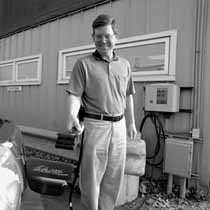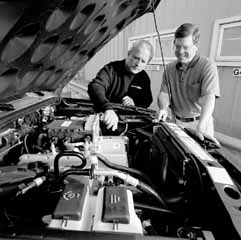 |
|
Silence is Golden by Mike Perricon Quietly (very quietly), Fermilab's Facilities Engineering Services Section has taken three significant steps toward complying with a major Federally-mandated reduction in fuel consumption. Under a 1999 executive order by President Clinton, federal agencies face a deadline of 2005 when they must cut their fleets' use of petroleum-based fuels by 20 percent from 1999 levels; specific saving strategies are left up to the agencies. At Fermilab, the strategy includes the recent delivery of three electrically-powered Ford Ranger pickup trucks. Ironically, the Ranger fails one critical visual test: from the outside, even from the inside, it's difficult to identify this truck as a four-wheeled paradigm-shifter.
Even the dashboard can fool you at first glance. It includes a "fuel gauge" with an apparently standard gas pump icon, and it takes some close peering-in to see that the pump's filler hose ends, not with a nozzle, but with an electric plug. The first overt sign that this isn't your Uncle Buck's pickup truck comes with turning the "ignition key:" Nothing happensónothing you can hear. It's as if the key goes only as far as the "Accessory" click. No coughing starter, no auditory cues that combustion is taking place. And, of course, there is no combustion taking place. The loudest noise comes during braking, with a little bass-toned "thrum" added to the faint whine of the 90-hp motor and single-speed, rear-mounted transaxle (acceleration is 0-50 in 12.5 seconds, though the lab speed limit is 40 mph). The Ranger uses regenerative braking to partially replenish the charge in the 39 eight-volt, sealed lead-acid batteries mounted under the frame. "It's pretty responsive, and it drives almost like a normal car," said Transportation Supervisor George Davidson. "I like the quiet. It seems kind of nice, but it is hard to get used to." The electric Ranger "Zero Emission Vehicles," leased from a local Ford dealer for three years through the Government Services Administration, will require a few other accommodations. Their range is optimistically estimated at 74 miles, but Davidson explained that estimate is based on a 72-degree day, with no heating or air conditioning, and no stop-and-go driving. He thought 40 to 50 miles was more realistic, though sufficient for on-site use by FESS engineers and technicians. The lab had to purchase three battery chargers (at $2,200 each) in order to use the electric Rangers; two have been installed at Site 39, and the third at Site 38, in the vehicle maintenance area. The trucks can be charged at any time; the batteries don't need to be completely run down, as with many cellular telephones. Davidson said drivers will be asked not to leave the truck idling, a major power drain. But as compensation in severe Batavia winters, the electrical system delivers heat instantly. Fermilab's transportation fleet of 264 vehicles uses about 95,000 gallons of fuel annually, including about 25,000 gallons of diesel fuel. In addition to the electric Rangers, FESS currently has alternative fuel vehicles in two other categories, but not yet the facilities to take full advantage of them: Compressed Natural Gasóthese nine vehicles can run on either gasoline or CNG, but the lab doesn't currently have a CNG refueling facility. In its energy partnership program with NICOR, which played a critical role in recent upgrades to the Central Utility Building (see "All Pumped Up," FERMINEWS, Vol. 22, No. 4, Feb. 19, 1999), the lab is working on a proposal to add a CNG tank to its fueling station, possibly in 2001. E-85 Flex Fuelóthese 10 vehicles (five are Fermilab's, five are GSA's) can run on gasoline or on mixtures of up to 85 percent alcohol (ethanol). FESS is seeking funding for 2002 to install the tanks and pumps capable of handling the ethanol mixture.
Davidson is keeping an e-mail log of comments from drivers of the electric Rangers, which are on a non-renewable lease and will be returned to Ford when the contract expires. "Maybe they'll even have a new and improved version by then," Shull said. "I think we've found a really good match." |
| last modified 12/15/2000 email Fermilab |
FRLsDFx9eyfrPXgV
 "I thought it might look a little hokey, but it really doesn't," said Bill Shull, FESS Operations Group Manager. "It looks, feels and drives just like a conventional vehicle. It's a more mature design than I anticipated. Unless you look under the hood, you think you're driving an internal combustion engine."
"I thought it might look a little hokey, but it really doesn't," said Bill Shull, FESS Operations Group Manager. "It looks, feels and drives just like a conventional vehicle. It's a more mature design than I anticipated. Unless you look under the hood, you think you're driving an internal combustion engine."
 FESS can also use "biodiesel" in its diesel-fueled vehicles, a mixture of 20 percent soy-based diesel added to conventional diesel fuel. Biodiesel is costly, but it requires no additional infrastructure and could become a more economical choice if diesel prices remain high.
FESS can also use "biodiesel" in its diesel-fueled vehicles, a mixture of 20 percent soy-based diesel added to conventional diesel fuel. Biodiesel is costly, but it requires no additional infrastructure and could become a more economical choice if diesel prices remain high.